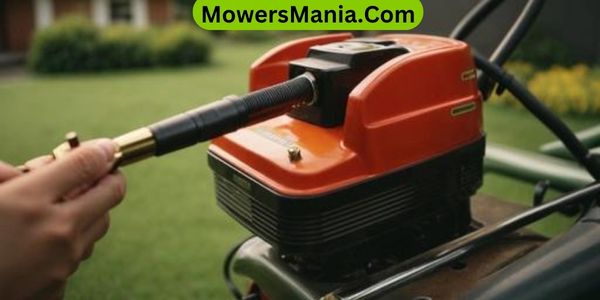If your lawn mower is having trouble starting, the problem could be with the ignition switch. Don’t worry, testing it is easier than you think!
In this article, we’ll show you how to test your lawn mower ignition switch using simple tools and a multimeter. By following these steps, you’ll be able to determine if the switch is working properly and make any necessary repairs or replacements.

So let’s get started and get your lawn mower running smoothly again!
Gather Necessary Tools and Materials
To test a lawn mower ignition switch, you’ll need to gather the necessary tools and materials. This step is crucial to ensure that you have everything you need before you start the testing process.
The tools and materials required are simple and readily available. First, you’ll need a multimeter, which is a device used to measure electrical currents and voltages. It’s essential for accurately testing the ignition switch.
Additionally, you’ll need a set of screwdrivers, preferably a Phillips and a flathead, to remove any screws or panels that may be covering the ignition switch. Make sure you have a clean cloth or rag handy to wipe away any dirt or debris that may be present on the switch.
Lastly, ensure that you have a pen and paper or a notepad to record any readings or observations during the testing process.
Disconnect the Spark Plug Wire
Disconnecting the spark plug wire is an essential step to ensure your safety and prevent any accidental starting of the mower during the testing process. To disconnect the spark plug wire, locate the spark plug on the engine.
It’s typically covered by a rubber boot. Firmly grasp the rubber boot and pull it off the spark plug. This will disconnect the wire from the spark plug and disable the ignition system.
By disconnecting the spark plug wire, you remove the source of ignition, preventing the mower from starting unexpectedly.
This is important because testing the ignition switch involves manipulating the wires and connections, which can cause sparks or electrical surges. Without disconnecting the spark plug wire, you risk injury or damage to the lawn mower.
Once you have disconnected the spark plug wire, you can proceed with testing the lawn mower ignition switch. Remember to follow the manufacturer’s instructions for testing the switch and use a multimeter to check for continuity or proper voltage output.
If the ignition switch is faulty, you may need to replace it to ensure proper starting and operation of your lawn mower.
Locate the Ignition Switch on Your Lawn Mower

To locate the ignition switch on your lawn mower, there are a few methods you can try. First, examine the control panel or dashboard. The ignition switch is typically located near the keyhole or in close proximity to it.
It’s usually a small, round or rectangular-shaped component with a keyhole in the center. Look for any labels or markings that indicate the switch’s purpose or position.
If you’re still having trouble finding it, refer to your lawn mower’s user manual for guidance. Another way to locate the ignition switch is by tracing the wires that connect to it.
Follow the wires from the spark plug to the control panel or dashboard, and you should find the switch along the way.
Additionally, some lawn mowers have a separate ignition module or coil that houses the ignition switch. In this case, you may need to remove a cover or panel to access the switch.
Remember to always disconnect the spark plug wire and take necessary safety precautions before attempting to locate or work on the ignition switch.
Use a Multimeter to Test the Ignition Switch
To test the ignition switch on your lawn mower, you’ll need to use a multimeter. This tool will help you troubleshoot any issues and determine if the ignition switch is functioning properly.
Multimeter Troubleshooting Techniques
To test the ignition switch on your lawn mower, you’ll need a multimeter. This handy tool will help you troubleshoot any issues and determine if the ignition switch is functioning properly.
Here are some troubleshooting techniques using a multimeter:
- Set the multimeter to the continuity or ohms setting.
- Disconnect the wire from the ignition switch.
- Place one probe on the wire connector and the other probe on the ignition switch terminal.
- Check for continuity or resistance reading.
- If there’s no continuity or a high resistance reading, the ignition switch may be faulty.
Using a multimeter allows you to accurately diagnose the problem with your lawn mower’s ignition switch. Make sure to follow proper safety precautions and consult your mower’s manual for specific instructions.
Ignition Switch Functionality
To test the functionality of your lawn mower’s ignition switch using a multimeter, you’ll need to obtain a proper reading of continuity or resistance. This will help determine if the ignition switch is functioning correctly or if it needs to be replaced.
Start by setting your multimeter to the ohms (Ω) setting. Then, locate the ignition switch on your lawn mower and disconnect the wire harness.
Connect the multimeter probes to the terminals of the ignition switch. When the switch is in the ‘Off’ position, there should be no continuity or resistance reading.
However, when the switch is in the ‘On’ position, there should be continuity or a low resistance reading. If the readings aren’t as expected, it indicates a faulty ignition switch that needs to be replaced.
Interpret the Multimeter Readings
Now that you have taken the multimeter readings, it’s time to interpret them. This step is crucial in troubleshooting the ignition switch.
Multimeter Reading Troubleshooting
You can troubleshoot the multimeter readings by using a few simple steps.
First, ensure that the multimeter is properly set to the correct measurement mode, such as voltage or resistance.
Next, check the connections between the multimeter and the ignition switch to ensure they’re secure and free from any damage.
If the readings aren’t within the expected range, try adjusting the multimeter’s settings or repositioning the probes.
Additionally, make sure that the ignition switch is in the correct position and functioning properly. If all else fails, consult the multimeter’s user manual or seek professional assistance.
Remember to always exercise caution when working with electrical components to avoid injury or damage.
- Set the multimeter to the correct measurement mode
- Check the connections for security and damage
- Adjust the multimeter settings or probe positions if needed
- Verify the ignition switch position and functionality
- Consult the multimeter’s user manual or seek professional help if necessary
Interpreting Ignition Switch Readings
To interpret the ignition switch readings, use a multimeter to measure the voltage or resistance of the switch. This will help you determine if the switch is functioning properly or if it needs to be replaced.
When using the multimeter, set it to the appropriate setting for voltage or resistance measurement. Then, connect the positive lead of the multimeter to the terminal of the ignition switch and the negative lead to a ground.
If the switch is functioning correctly, the multimeter should display a voltage reading or show low resistance. However, if the switch is faulty, the multimeter may either display no voltage or show high resistance.
Replace or Repair the Ignition Switch if Necessary

If your lawn mower ignition switch is faulty, it’s time to consider replacing or repairing it. Ignition switches are crucial components that allow you to start your lawn mower and control its operation. When they fail, it can be frustrating and hinder your ability to maintain your lawn.
Here are a few pointers to help you decide whether to replace or repair the ignition switch:
- Inspect for visible damage: Check the ignition switch for any signs of physical damage, such as cracks or broken parts. If you notice any, it’s likely that the switch needs to be replaced.
- Test the continuity: Use a multimeter to test the continuity of the ignition switch. If there’s no continuity when the switch is turned to the ‘ON’ position, it may need to be replaced.
- Consider the cost: Evaluate the cost of repairing versus replacing the ignition switch. Sometimes, it may be more cost-effective to replace the entire switch rather than repair it.
- Availability of parts: Determine whether replacement parts for your specific ignition switch are readily available. If they’re scarce or expensive, repairing the switch may not be feasible.
- Level of expertise: Assess your own mechanical skills and determine if you have the knowledge and tools required to repair the ignition switch. If not, it may be best to leave it to a professional.
Frequently Asked Questions [FAQs]
How Often Should I Test My Lawn Mower Ignition Switch?
You should test your lawn mower ignition switch regularly to ensure it’s functioning properly. Regular testing helps prevent any unexpected issues and ensures your mower starts reliably when you need it.
Can I Use Any Type of Multimeter to Test the Ignition Switch?
You can use any type of multimeter to test the ignition switch. Just make sure it has the capability to measure resistance. Follow the instructions in your mower’s manual for accurate testing.
Is It Necessary to Disconnect the Spark Plug Wire Before Testing the Ignition Switch?
Before testing the ignition switch, it is necessary to disconnect the spark plug wire. This prevents the engine from accidentally starting while you’re working on the switch, ensuring your safety.
What Are the Common Signs of a Faulty Ignition Switch?
If your ignition switch is faulty, you may experience issues like difficulty starting the lawn mower, engine stalling, or the mower not turning off. It’s important to test it properly to ensure it’s the cause.
Can I Repair the Ignition Switch Myself, or Should I Hire a Professional?
You can repair the ignition switch yourself if you’re comfortable with electrical work. However, if you’re unsure or don’t have experience, it’s best to hire a professional for safety reasons.
Conclusion
In conclusion, testing a lawn mower ignition switch is a straightforward process that can be done using a multimeter. By following the outlined steps and interpreting the readings correctly, you can determine if the ignition switch is functioning properly.
If any issues are found, it may be necessary to replace or repair the ignition switch to ensure your lawn mower starts efficiently.



